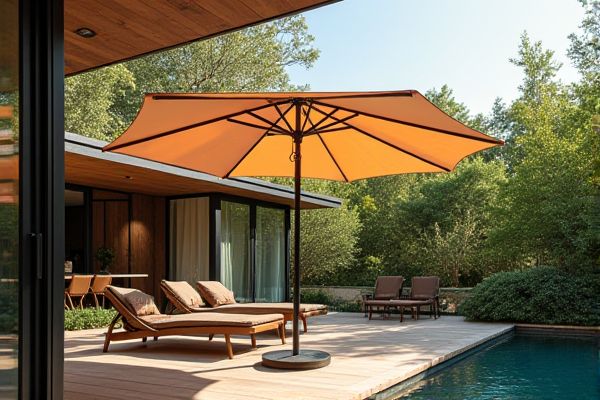
Patio parasols and sun umbrellas both provide shade but differ in design, durability, and intended use, with patio parasols typically being sturdier and better suited for outdoor furniture setups, while sun umbrellas offer more portability for casual outings. Discover the key factors to consider when choosing the perfect shade solution for your outdoor space in the rest of this article.
Table of Comparison
| Feature | Patio Parasol | Sun Umbrella |
|---|---|---|
| Purpose | Designed for outdoor patios and seating areas | Portable shade for outdoor use like beaches and parks |
| Size | Larger, typically 6-13 feet diameter | Smaller, usually 3-7 feet diameter |
| Material | Durable, weather-resistant fabrics (polyester, olefin) | Lightweight, UV-protective fabrics |
| Base | Heavy stand or weighted base for stability | No base, held by user or inserted into sand |
| Portability | Less portable, designed to stay in place | Highly portable and easy to carry |
| Adjustability | Tilt and crank options for angle and height adjustment | Limited tilt, mostly fixed angle |
| Price Range | Typically $100-$600 | Typically $20-$100 |
| Ideal Use | Permanent or semi-permanent outdoor shade solution | Temporary shade for travel and recreation |
Understanding Patio Parasols and Sun Umbrellas
Patio parasols feature sturdy poles and large, durable canopies designed to provide extensive shade for outdoor seating areas, often equipped with tilt and crank mechanisms for adjustable coverage. Sun umbrellas are typically smaller, portable, and lighter, ideal for personal use on beaches or poolsides, emphasizing ease of transport and quick setup. Both serve the purpose of sun protection, but patio parasols prioritize stability and longevity, while sun umbrellas focus on mobility and convenience.
Key Differences Between Patio Parasols and Sun Umbrellas
Patio parasols typically feature a sturdy central pole and a heavier base designed for fixed outdoor use, providing broad shade coverage ideal for patios or garden seating areas. Sun umbrellas tend to be lighter, portable, and often foldable, making them convenient for beach trips or casual outdoor activities. Understanding these differences helps you choose the right option for your outdoor shading needs based on durability, portability, and intended use.
Design and Structure Comparison
Patio parasols typically feature a sturdy, heavy base and a thicker pole designed for stable outdoor use, often incorporating tilt and crank mechanisms for easy adjustment, while sun umbrellas are usually lighter with simpler frames intended for portability. The canopy design on patio parasols is often larger and made from UV-resistant, weatherproof materials to provide long-lasting shade, whereas sun umbrellas prioritize compactness and quick setup with less durable fabric. You can choose a patio parasol for a permanent backyard fixture or a sun umbrella for flexible, on-the-go sun protection.
Material and Durability Overview
Patio parasols typically feature high-quality materials such as aluminum or steel frames paired with UV-resistant polyester or acrylic fabric, ensuring long-lasting durability against sun exposure and weather elements. Sun umbrellas often use lighter materials like fiberglass poles and standard polyester fabric, which may offer less resistance to wear and tear over time. To maximize your outdoor comfort, choosing a parasol with robust construction and weatherproof fabric will provide superior longevity and protection.
Ease of Use and Portability
Patio parasols typically feature heavier bases and larger canopies, which provide stability but reduce portability, making them ideal for fixed outdoor spaces. Sun umbrellas are designed to be lightweight and foldable, allowing easy transport and quick setup for beach or park use. Your choice depends on whether you prioritize stationary ease of use or the convenience of portability.
Weather Protection: Shade and UV Resistance
Patio parasols provide superior weather protection with sturdy materials designed to withstand wind and rain, offering consistent shade and high UV resistance. Sun umbrellas typically focus on portability and ease of use, providing effective shade but often less durability against harsh weather conditions. Choosing the right option enhances your outdoor comfort by ensuring your space remains shielded from the sun's harmful rays and variable weather, protecting Your skin and outdoor furnishings.
Versatility for Various Outdoor Spaces
Patio parasols offer greater versatility for various outdoor spaces due to their larger sizes and adjustable tilt mechanisms, making them ideal for patios, decks, and garden areas of different dimensions. Sun umbrellas are typically more portable and compact, suited for small balconies, beach use, or temporary shading needs. The choice depends on the available space and the intended level of coverage and mobility required.
Aesthetic Appeal and Style Options
Patio parasols offer a wide range of styles, from classic market designs to modern cantilever options, enhancing outdoor aesthetics with elegant, permanent installations. Sun umbrellas prioritize portability with diverse colors and patterns, allowing quick style changes to match casual settings. Choosing between them depends on desired visual impact and flexibility in outdoor decor.
Maintenance and Longevity
Patio parasols typically feature sturdier frames and weather-resistant fabrics designed for long-term outdoor use, making maintenance easier with occasional cleaning and protective covers. Sun umbrellas often have lighter materials that require more frequent care to prevent fading and fabric deterioration, especially under strong UV exposure. Investing in a patio parasol enhances your outdoor space's durability while minimizing the effort needed to keep your shade solution looking and functioning well.
Choosing the Best Option for Your Outdoor Needs
Patio parasols typically offer larger coverage and sturdier construction, making them ideal for fixed outdoor seating areas or patios. Sun umbrellas are often more portable and lightweight, providing flexible shade solutions for on-the-go use such as beaches or picnics. Choosing the best option depends on your outdoor space size, mobility requirements, and desired durability for long-term sun protection.
 homyna.com
homyna.com